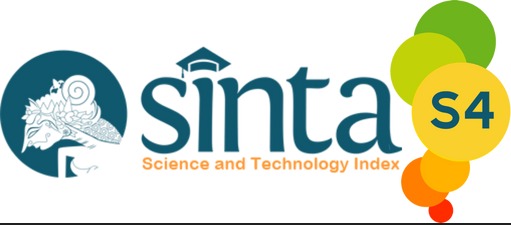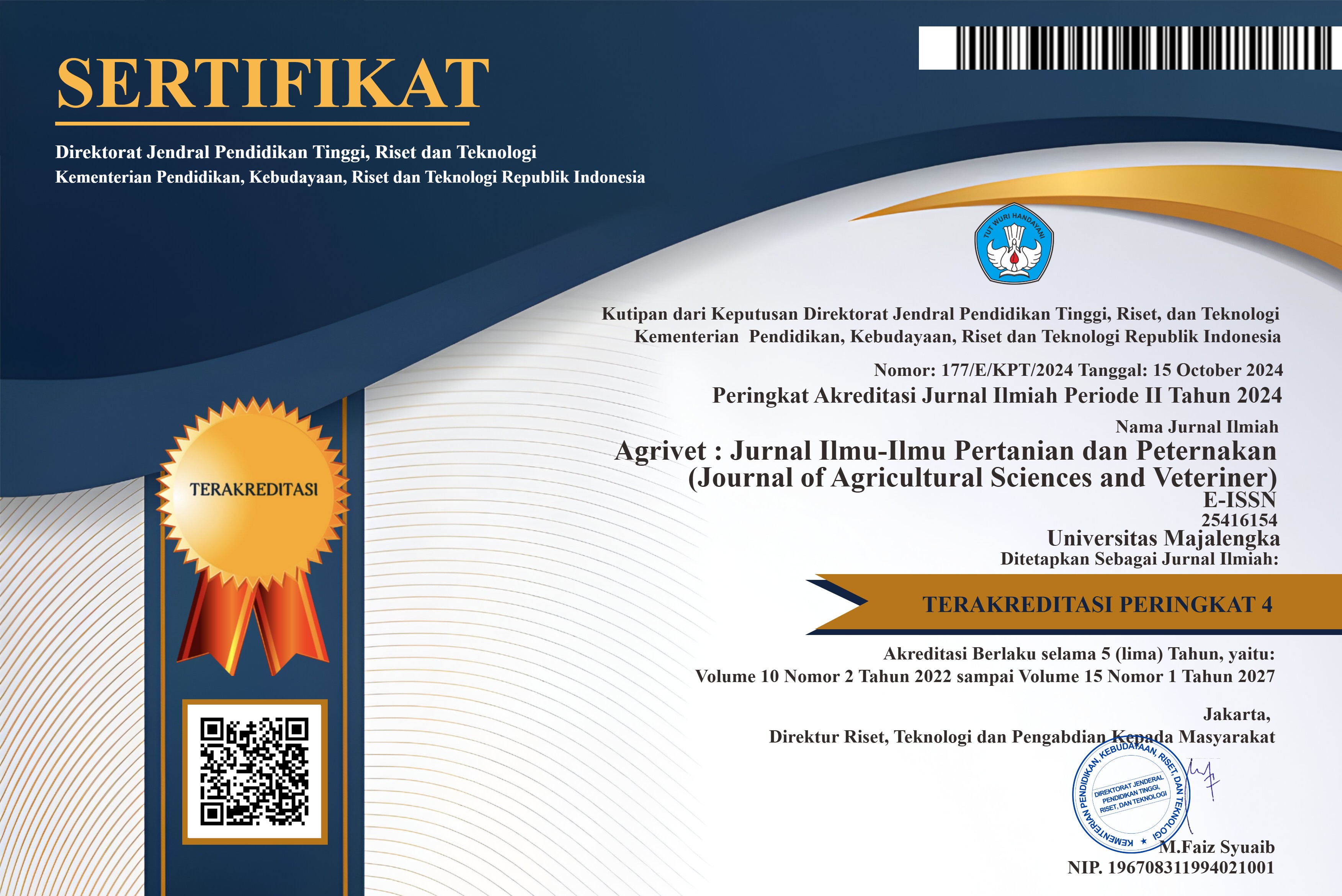Aplikasi kombinasi penggunaan POC ikan lemuru dan pupuk anorganik NPK pada budidaya tanaman padi
DOI:
https://doi.org/10.31949/agrivet.v11i1.5878Abstract
Soil productivity that declines due to the continuous use of inorganic fertilizers for a long period of time has an impact on decreasing the production of rice produced. The need to use organic fertilizers such as liquid organic fertilizer made from lemuru fish to balance soil properties. This study aimed to determine the combination of the use of lemuru fish LOF and NPK fertilizer in rice plant cultivation. The experiment was conducted using a non-factorial complete randomized design with the addition of lemuru fish LOF concentrations as a treatment consisting of 0 ml/l water (P0), 30 ml/l water (P1), 40 ml/l water (P2), 50 ml/l water (P3), and 60 ml/l water (P4). The results showed that the addition of POC lemuru fish with a concentration of 0 ml/l of water gave the best results on all observation variables, namely the number of the productive tiller (21.47), panicle length (21.40 cm), the number of grain per panicle (130.40 grains), the weight of dry rice fields (56.08 g), and the weight of filled grain (4.68 g). It can be concluded that the low nutrient content and little frequency of application were suspected to cause a significant increase in rice crop production.
Keywords:
consentration, nutrient, lemuru fish, rice plantDownloads
References
Abu RLA, Basri Z, Made U. 2017. Response of Growth and Yield of Rice (Oryza sativa L.) Plant on the Need for Nitrogen Using Leaf Color Chart. J Agrol. 24(2):119–127.
Arifan F, Wikanta DK. 2011. Optimasi Produksi Ikan Lemuru (Sardinella Longiceps) Tinggi Asam Lemak Omega-3 Dengan Proses Fermentasi Oleh Bakteri Asam Laktat. Pros Semin Nas Sains Dan Teknol Fak Tek. 1(1):15–20.
Arinta K, Lubis I. 2018. Pertumbuhan dan Produksi Beberapa Kultivar Padi Lokal Kalimantan. Bul Agrohorti. 6(2):270–280.
Badan Pusat Statistik. 2022. Luas Panen dan Produksi Padi di Indonesia (BRS No. 21/03/Th. XXV, 1 Maret 2022). Jakarta.
Baharuddin R. 2016. Respon pertumbuhan dan hasil tanaman cabai (Capsicum annum L.) terhadap pengurangan dosis NPK 16: 16: 16 dengan pemberian pupuk organik. Din Pertan 32(2):115–124.
Febrianna M, Prijono S, Kusumarini N. 2018. Pemanfaatan Pupuk Organik Cair Untuk Meningkatkan Serapan Nitrogen Serta Pertumbuhan Dan Produksi Sawi (Brassica juncea L.) Pada Tanah Berpasir. J Tanah dan Sumberd Lahan. 5(2):1009–1018. http://jtsl.ub.ac.id
Habibullah M, Idwar, Murniati. 2015. Effect of Fertilizer N, P, K and Organic Liquid Fertilizer (OLF) on the Growth and Efficiency of Upland Rice Production (Oryza sativa L.) in Medium Ultisol. J Online Mhs Bid Pertan. 2(2).
Ishaq M, Rumiati AT, Permatasari EO. 2017. Analisis Faktor-Faktor yang Mempengaruhi Produksi Padi di Provinsi Jawa Timur Menggunakan Regresi Semiparametrik Spline. J Sains dan Seni ITS. 6(1):420–425. https://doi.org/10.12962/j23373520.v6i1.22451
Istiqomah N, Mahdiannoor, Asriati F. 2016. Pemberian Berbagai Konsentrasi Pupuk Organik Cair (POC) Terhadap Pertumbuhan Dan Hasil Padi Ratun. Ziraa’Ah. 41(3):296–303.
Kumape H, Samudi S, Made U. 2021. Pertumbuhan dan Hasil Padi (Oryza Sativa L.) Pada Berbagai Konsentrasi Pupuk Organik Cair. J Agrotekbis. 9(1):78–84.
Mardiana Y. 2021. Efektivitas Aplikasi Poc Pada Pertumbuhan Dan Produksi Beberapa Varietas Padi (Oryza Sativa L.). J Multidisiplin Madani. 1(3):355–366. https://doi.org/10.54259/mudima.v1i3.243
Masluki, Naim M, Mutmainnah. 2015. Pemanfaatan Pupuk Organik Cair (POC) Pada Lahan Sawah Melalui Sistem Mina Padi. Pros Semin Nas. 02(1):866–874.
Murnita, Taher YA. 2021. Dampak Pupuk Organik dan Anorganik terhadap Perubahan Sifat Kimia Tanah dan Produksi Tanaman Padi (Oriza sativa L.). J Menara Ilmu. 15(2):67–76.
Nugroho CC, Karno, Supriyono. 2020. Efektivitas Pupuk Organik Cair Keong Mas Terhadap Pertumbuhan dan Hasil Padi Varietas Ciherang. J Magrobis. 20(02):203–2014.
Pertami ND, Rahardjo MF, Damar A, Nurjaya IW. 2020. Ikan Lemuru, Primadona Perikanan Selat Bali yang Menghilang. War Iktiologi. 4(April):1–7.
Rahmad D, Nurmianty, Halid E, Ridwan A, Baba B. 2022. Karakterisasi Pertumbuhan Dan Produksi Beberapa Varietas Padi Unggul Characterization Growth and Production Some Superior Rice Varieties. J Agroplantae. 11(1):37–45.
https://doi.org/10.51978/agro.v11i1.383
Sa’diyah H, Hadi AFH, Ilminnafik N. 2015. IbM Kelompok Nelayan Lemuru di Desa Puger Wetan. :1–11.
Sinurat BRKD. 2022. Uji Dosis POC Terhadap Produksi Beberapa Varietas Tanaman Padi (Oryza sativa L) Di Sela Tegakan Kelapa Sawit Umur 9 Tahun. J Ilm Mhs Pertan. 2(3):1–14.
Sitinjak H, Idwar. 2015. Respon Berbagai Varietas Padi Sawah (Oryza sativa L.) yang Ditanam Dengan Pendekatan Teknik Budidaya Jajar Legowo dan Sistem Tegel. J Online Mhs Bid Pertan. 2(2).
Yusdian Y, Kantikowati E, Hadipraja R. 2020. Respon Tanaman Padi Sawah (Oryza sativa L.) Varietas Ciherang Terhadap Takaran Pupuk Kandang Ayam Dan Urien Kelinci. J Agro Tatanen. 2(3):15–21.
Published
How to Cite
Issue
Section
License
Copyright (c) 2023 Winda Hasma, Damanhuri

This work is licensed under a Creative Commons Attribution-ShareAlike 4.0 International License.
An author who publishes in the Jurnal Agrivet agrees to the following terms:
- Author retains the copyright and grants the journal the right of first publication of the work simultaneously licensed under the Creative Commons Attribution-ShareAlike 4.0 License that allows others to share the work with an acknowledgment of the work's authorship and initial publication in this journal
- The author is able to enter into separate, additional contractual arrangements for the non-exclusive distribution of the journal's published version of the work (e.g., post it to an institutional repository or publish it in a book) with the acknowledgment of its initial publication in this journal.
- The author is permitted and encouraged to post his/her work online (e.g., in institutional repositories or on their website) prior to and during the submission process, as it can lead to productive exchanges, as well as earlier and greater citation of the published work









